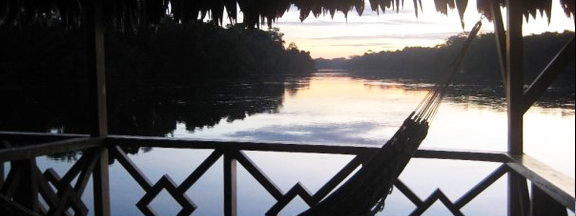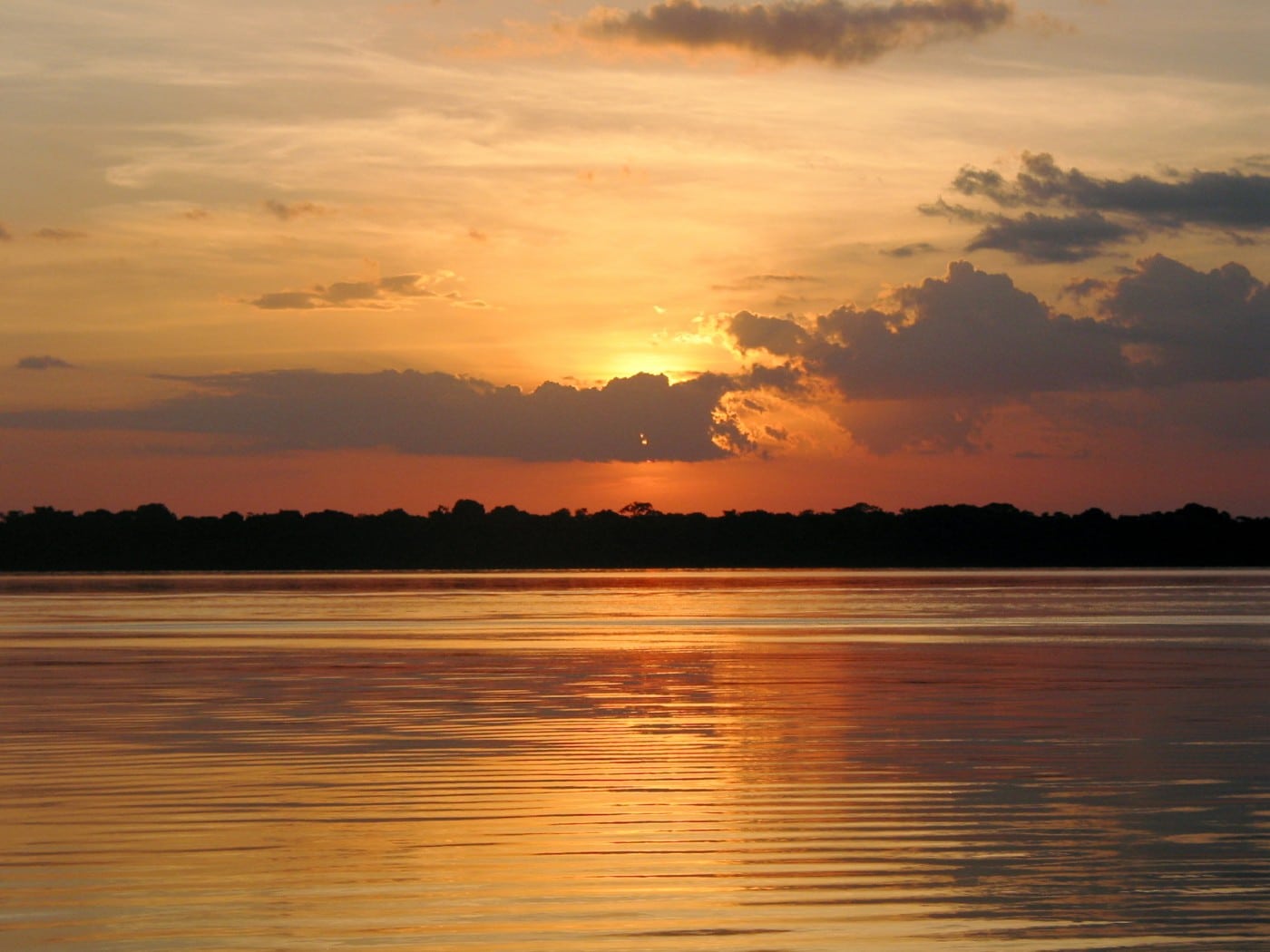I’m sitting on the terrace of the lodge, and as if by magic the evening’s backdrop draws gracefully towards me. Colored a faint bluish grey, the slanted curtain of water begins with a light tap, tap, tap, then slowly the downpour takes over. It is so naturally orchestrated, like the waves gently sloshing against my cabin, lulling me.
 A humid breeze slows the patter so that under my thatched gazebo I can hardly feel the tiny droplets. Gazing at the shore, a green meadow drifts by reminding me that this is a flood plain. The sudden shower passes but stays just long enough to refresh the river and pousada. The setting is the Uacari Lodge, the floating hub of The Reserva de Desenvolvimento Sustentavel Mamiraua (Mamiraua Sustainable Development Reserve).This is where I decided to discover the Amazon. Declared a reserve in 1996, Mamiraua includes 11,240 square meters of the only remaining floodplain forest in the northernmost part of the Brazilian Amazonia. It was granted by the government to a group of scientists as a new habitat for the nearly extinct Uacari monkey. Undisputedly the pioneer of sustainable development, Mamiraua has successfully combined nature conservation, scientific research and opportunities for the local people with an eco adventure experience for the leisure traveler. For me coming here was a dream finally being made real.
A humid breeze slows the patter so that under my thatched gazebo I can hardly feel the tiny droplets. Gazing at the shore, a green meadow drifts by reminding me that this is a flood plain. The sudden shower passes but stays just long enough to refresh the river and pousada. The setting is the Uacari Lodge, the floating hub of The Reserva de Desenvolvimento Sustentavel Mamiraua (Mamiraua Sustainable Development Reserve).This is where I decided to discover the Amazon. Declared a reserve in 1996, Mamiraua includes 11,240 square meters of the only remaining floodplain forest in the northernmost part of the Brazilian Amazonia. It was granted by the government to a group of scientists as a new habitat for the nearly extinct Uacari monkey. Undisputedly the pioneer of sustainable development, Mamiraua has successfully combined nature conservation, scientific research and opportunities for the local people with an eco adventure experience for the leisure traveler. For me coming here was a dream finally being made real. Everything unfolds with natural grandeur in the Amazon. After a bumpy hour commuter flight from the crumbling city of Manaus (the rubber barons long gone) I arrive in Tefe, a dusty river town and gate-way to the lush waterways of the famous river. A two-hour boat ride up Rio Solimoes begins to reveal the drama of the four-day adventure. As we round the port entrance an immense body of “white water” oddly colored a chalky brown opens up and we face an intense blue sky dotted with cottony clouds. We hug the coast nodding respectfully to our neighbors who glide by in canoes. While we’re the only motor on the waters, the quiet explosion of it all — the welcoming rays, the neon blue butterflies, the flirting kingfishers – seem to mute the engines. As I’ve arrived in the rainy season, the lodge is now a series of floating cabins tethered together. The flotilla structure is a practical necessity for it makes it easy to flow with major water level changes (plus or minus 20 meters) from the dry to rainy seasons.
Everything unfolds with natural grandeur in the Amazon. After a bumpy hour commuter flight from the crumbling city of Manaus (the rubber barons long gone) I arrive in Tefe, a dusty river town and gate-way to the lush waterways of the famous river. A two-hour boat ride up Rio Solimoes begins to reveal the drama of the four-day adventure. As we round the port entrance an immense body of “white water” oddly colored a chalky brown opens up and we face an intense blue sky dotted with cottony clouds. We hug the coast nodding respectfully to our neighbors who glide by in canoes. While we’re the only motor on the waters, the quiet explosion of it all — the welcoming rays, the neon blue butterflies, the flirting kingfishers – seem to mute the engines. As I’ve arrived in the rainy season, the lodge is now a series of floating cabins tethered together. The flotilla structure is a practical necessity for it makes it easy to flow with major water level changes (plus or minus 20 meters) from the dry to rainy seasons.

The lodge has been written up as the most eco-friendly resort in the world. I was happy to see that the award truly recognized the “eco” and “friendly” but didn’t include the pretense that comes with “resort.” Upon arrival I
was greeted by the staff whose warm, genuine smiles were welcoming. They were all locals except for two from Tefe and a brother and sister duo who spoke English and worked as hosts. It was Misha, the sister’s, tour of duty. She and her brother were from Santa Catarina, in the south of Brazil, known for its amazing beaches and high standard of living. They were both Roman-nosed, Rubenesque and trying to tame curly brown locks.
The rooms were spare and spacious with a simple décor but the terrace’s hammock promised siestas swinging over the river. Rustic but well mended and mosquito tight, it was ready to be my home for the few nights. The first evening, while daylight dimmed and the rain subsided, the creak, creak, creaking of the log barges were constant as the current swayed the
string of huts. The night’s loud symphony began with bats and howlers amplified in the quiet twilight followed by a cacophony of buzzzzes, cawwws, whooooshes and splaaashes that could spark even the dimmest imagination. I would come to meet the wonders of the Amazon soon enough I thought on my unsteady walk to dinner while shadowed eyes followed me from the riverbanks.
After dinner I learned from Misha that the days ahead would include morning canoe rides through the flooded jungle, a trip to the pink dolphin research center and afternoon bird-watching expeditions on the big river. Paddling silent chocolate waters at dawn conjured up images of the path to Hades in my mind. Here we breakfasted with the red howling Guariba, Capuchin, and spider monkeys, the shadow of the elusive Uacari, and mosquitoes. Actually, the stealthy bloodsuckers munched heartily on us, our repellents a sweet sauce on their main course. When I saw the small toffee furred Guariba, I found it hard to believe that she could make the fierce noise that kept me tossing all night.
These trips were peaceful even though at times a bit unnerving. Because we sat so low in the water, I felt I had to keep one eye up and one eye down. My boat mate was terrified most of the time and kept praying under her breath, “Por favor, Deus, me salve!” (“please, God, save us”) It was a bit bizarre but at the same time, I did think that while I was in no position to ask any favor of “Deus”, he might take pity on me and save me along with Susannah. Poor Susannah. I’m afraid her imagination got the best of her. When she began babbling about jaguars which she was sure were going to pounce from their lazy perches high in the tree, bored with Capuchin kebabs to try tasty Brasiliera and Americana meat, it became clear that with this trip she had perhaps bitten off more than she could chew. Susannah didn’t last much longer on the dawn paddles. When she suggested that Eduardo, our Indian guide, carry a gun in the boat, the Lodge decided that she might be happier in her hammock.
One of our expeditions took us to a pink dolphin research center, really just an aging houseboat nestled between two tributaries. Two visiting biologists were tasked to track this freshwater river species which is facing extinction to discover its feeding and mating patterns. Found only in the tributaries and main rivers of the Orinoco River (mostly Brazil and Peru), the “boto” as it’s known in the Amazon is truly a pearly pink, the coloring mostly from capillaries near the surface of the skin. We were invited to join one of the daily-scouting missions only to learn how hard it is to see these magical looking creatures. They come up for air quickly and infrequently and when they do, having a hump on their back rather than a dorsal fin makes them elusive. Besides their mirage-like images, what I found most bewitching is their spout whistle – akin to the soft blow of a conch shell.
I can’t call myself a bird watcher (who can?) but it was surprisingly fascinating. The wide variety of winged creatures was staggering. I saw yellow and redheaded woodpeckers tapping for insects, the majestic gavia, or hawk, swooping over the waters in search of lunch, and the noble owl patiently observing. While the kingfisher was our ever-present beacon, the tiny macaw was the noisy siren blasting our presence.
And while I’m on the subject of presence, let’s give credit where credit’s due … Marcelo, our chef, was spectacular. I never imagined how many things you could do with bananas. We had them flambéed, in a fruit salad and casserole, as fritters, in a tapioca tart and of course, banana pie. With bananas and condensed milk he worked wonders. In addition to a variety of European dishes, we had at least five different types of fish, all delicious, especially the jaraqui. It was the ultimate meaty, juicy fish, wrapped in none other than a banana leaf, naturally.
Perfectly satiated by Marcelo’s Amazonia fare, I still remember my last night. The soft creaking of the barge, the rhythmic swoosh of the bats, the watery blinks of the caiman accented by the blows of the pink boto and the horn of the guariba – these sounds of the natural grandeur of the reserve were now my lullaby – and I fell fast asleep.

